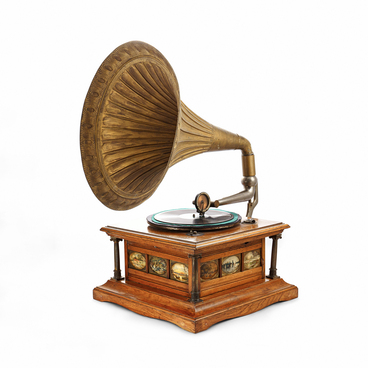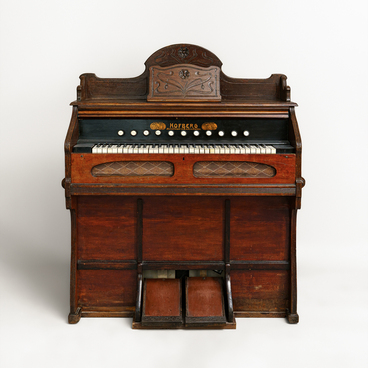The pathephone from the collection of the Lipetsk Regional Museum of Local Lore was produced at the Molot factory in Vyatskiye Polyany, Kirov Oblast, in the early 1950s. It was donated to the museum in 1967 by Vladimir Savelyev, the editor of the regional newspaper “Leninets”.
A pathephone is a portable record-playing device. Unlike a gramophone, it has a small built-in horn. The device itself resembles a briefcase that can be locked and carried using a special handle. The first pathephones were produced by a French company — Pathé. The name of the device comes from the family name of the company owners and the Greek word for “sound”. The horn is hidden inside a wooden case covered in maroon leatherette. Under the hinged lid, there is a rotating metal turntable where records are placed. The turntable was rotated by a spring-powered winding mechanism with a removable crank handle. A stylus attached to a diaphragm moves along the groove which spirals from the center of the record to the outer edge. The stylus picks up the vibrations from the grooves on the record which are amplified, sent through the horn, and converted to sounds. The volume of the sound produced by the pathephone can be quite high, reaching around 80–100 decibels (dB). The quality of the sound depends on several factors, such as the wear of the stylus and the fine-tuning of the diaphragm in the sound box. There is no way to adjust the volume on the pathephone. According to the method used for playing records made of ebony and shellac, the stylus should be replaced for each side of the record. This determines the clarity and quality of the sound. The speed of the engine can be adjusted using a centrifugal governor. The recording standard is 78 rpm. It means that an average of three minutes of sound can be recorded on one side of the disk. One winding was usually enough to play one side of a record, in some cases two.
Pathephones were still widely used in the first half of the 20th century. However, they began to be replaced by electric phonographs in the mid-1950s.





